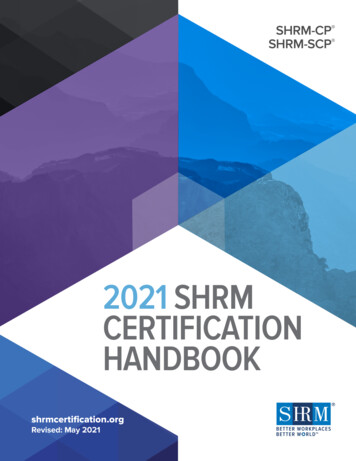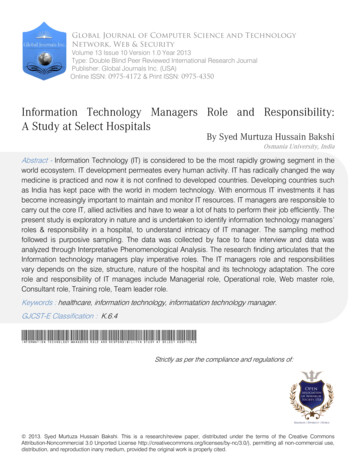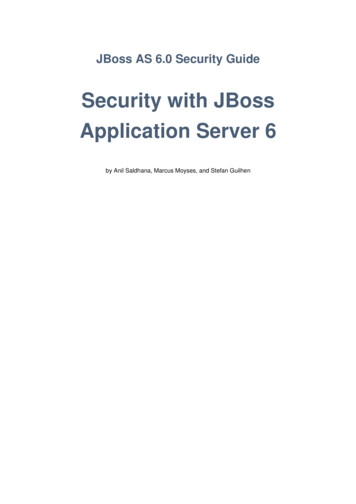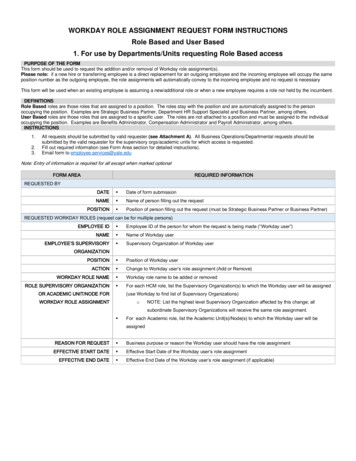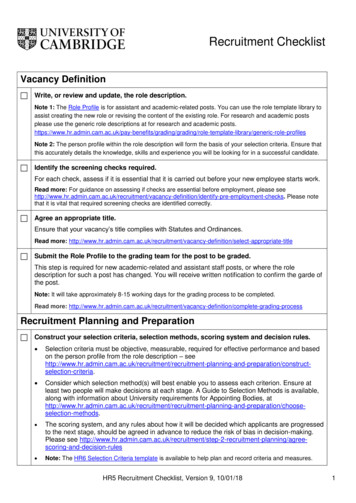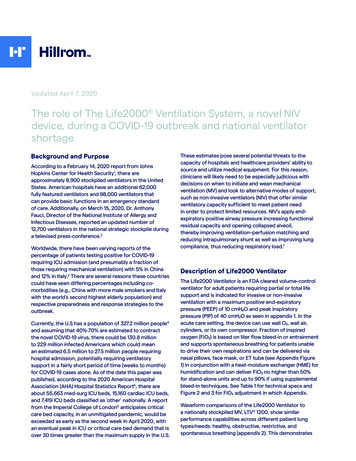
Transcription
Updated April 7, 2020The role of The Life2000 Ventilation System, a novel NIVdevice, during a COVID-19 outbreak and national ventilatorshortageBackground and PurposeAccording to a February 14, 2020 report from JohnsHopkins Center for Health Security1, there areapproximately 8,900 stockpiled ventilators in the UnitedStates. American hospitals have an additional 62,000fully featured ventilators and 98,000 ventilators thatcan provide basic functions in an emergency standardof care. Additionally, on March 15, 2020, Dr. AnthonyFauci, Director of the National Institute of Allergy andInfectious Diseases, reported an updated number of12,700 ventilators in the national strategic stockpile duringa televised press-conference.2Worldwide, there have been varying reports of thepercentage of patients testing positive for COVID-19requiring ICU admission (and presumably a fraction ofthose requiring mechanical ventilation) with 5% in Chinaand 12% in Italy.3 There are several reasons these countriescould have seen differing percentages including comorbidities (e.g., China with more male smokers and Italywith the world’s second highest elderly population) andrespective preparedness and response strategies to theoutbreak.Currently, the U.S has a population of 327.2 million people4and assuming that 40%-70% are estimated to contractthe novel COVID-19 virus, there could be 130.8 millionto 229 million infected Americans which could meanan estimated 6.5 million to 27.5 million people requiringhospital admission, potentially requiring ventilatorysupport in a fairly short period of time (weeks to months)for COVID-19 cases alone. As of the date this paper waspublished, according to the 2020 American HospitalAssociation (AHA) Hospital Statistics Report5, there areabout 55,663 med-surg ICU beds, 15,160 cardiac ICU beds,and 7,419 ICU beds classified as ‘other’ nationally. A reportfrom the Imperial College of London6 anticipates criticalcare bed capacity, in an unmitigated pandemic, would beexceeded as early as the second week in April 2020, withan eventual peak in ICU or critical care bed demand that isover 30 times greater than the maximum supply in the U.S.These estimates pose several potential threats to thecapacity of hospitals and healthcare providers’ ability tosource and utilize medical equipment. For this reason,clinicians will likely need to be especially judicious withdecisions on when to initiate and wean mechanicalventilation (MV) and look to alternative modes of support,such as non-invasive ventilators (NIV) that offer similarventilatory capacity sufficient to meet patient needin order to protect limited resources. NIV’s apply endexpiratory positive airway pressure increasing functionalresidual capacity and opening collapsed alveoli,thereby improving ventilation–perfusion matching andreducing intrapulmonary shunt as well as improving lungcompliance, thus reducing respiratory load.7Description of Life2000 VentilatorThe Life2000 Ventilator is an FDA cleared volume-controlventilator for adult patients requiring partial or total lifesupport and is indicated for invasive or non-invasiveventilation with a maximum positive end-expiratorypressure (PEEP) of 10 cmH2O and peak inspiratorypressure (PIP) of 40 cmH2O as seen in appendix 1. In theacute care setting, the device can use wall O2, wall air,cylinders, or its own compressor. Fraction of inspiredoxygen (FiO2) is based on liter flow bleed-in or entrainmentand supports spontaneous breathing for patients unableto drive their own respirations and can be delivered vianasal pillows, face mask, or ET tube (see Appendix Figure1) in conjunction with a heat-moisture exchanger (HME) forhumidification and can deliver FiO2 no higher than 50%for stand-alone units and up to 90% if using supplementalbleed-in techniques. See Table 1 for technical specs andFigure 2 and 3 for FiO2 adjustment in which Appendix.Waveform comparisons of the Life2000 Ventilator toa nationally stockpiled MV, LTV 1200, show similarperformance capabilities across different patient lungtypes/needs: healthy, obstructive, restrictive, andspontaneous breathing (appendix 2). This demonstrates
that it can be used in patients needing ventilatory supportwho do not require ventilation that exceed maximumoutput capabilities of the Life2000 device.Clinical Considerations for Applicability.The Life2000 Ventilator’s small form factor and low-profilenasal pillow interface allows for utilization across variousacute care settings, including the following: ER/ED, Med/Surg Recovery, general floor, and post-ventilator weaningsupport.Traditional face masks have a limitation of anatomicaldead space where CO2 blow off can require higher PEEPsettings. This limitation can be avoided with Life2000 nasalpillows that conform to the nostril, creating a seal thatprevents leakage, while eliminating the risk of nasal bridgeskin breakdown and the formation of mask pressure ulcersfrom prolonged periods of NIV usage.8The benefits of weaning patients from MV to NIV has beenwell established in clinical research and meta-analysis9and can significantly reduce risk for other nosocomialinfections and lung injury. It is recommended thatclinicians use best practices that are in line with theirfacilities’ standards and professional guidelines.ARDS Specific Considerations.(PP) when position was maintained for a minimum of 2hours a day and had significantly improved PaO2/FiO2in comparison to respective standalone therapies. Theunique Life2000 Ventilator configuration combines thebenefit of nasal pillows to reduce dead space (typicallyseen in HFNC) and positive pressure therapy (reserved toNIV) that may assist in patient tolerance and therapeuticeffectiveness.It is recognized that more moderate to severe cases ofARDS may exclude the use of NIV systems like Life2000Ventilator due to the increased demand of PEEP 12cmH2O and a higher rate of NIV failure in these cases.Current recommendations from The American ThoracicSociety (ATS)10 state early predictors of NIV failure includehigher severity score, older age, ARDS or pneumoniaas the etiology for respiratory failure, or a failure toimprove after 1 hour of treatment. This sentiment wasrecently reiterated by the Chinese Clinical Guidancefor COVID-19 Pneumonia Diagnosis and TreatmentGuidelines.13 Clinicians should use careful considerationsand best practice guidelines established by the AmericanAssociation of Critical-Care Nurses (AACN), ATS, and otherprofessional organizations when evaluating patients whoare at risk for or are presenting with ARDS and mode ofventilation selected.ConclusionThoughtful patient selection and NIV application can beextremely important in pandemic situations where thereis a shortage of full capacity mechanical ventilators. Atthe core of the above clinical considerations should beinterdisciplinary clinician driven protocols and guidelinesthat are consistent with best practices. Continuedunderstanding of novel ventilation devices and their rolein patient care is critical to improving clinician knowledgeand improved patient outcomes in times of crisis. Thedistinctive features of Life2000 Ventilator may add clinicalbenefit in an acute care setting by reducing burden ofNumerous professional organizations10-11 and other peermore invasive forms of ventilation without compromisingreviewed studies have suggested that lying a patient prone patient safety and outcomes.may help improve oxygen levels in the blood and increasesurvival in patients at risk or with mild to moderateARDS. In a recent 2020 multicenter prospective cohortstudy12, investigators combined the prone technique withthe addition of High-Flow Nasal Canula (HFNC) or NIVtreatment and found that when patients with pneumoniasecondary to influenza and other viral infections wereadmitted to a hospital, those with mild ARDS had areduced risk of progressing to invasive ventilation whenusing HFNC/NIV in combination with a prone positionPatients who are at risk for developing Acute RespiratoryFailure (ARF) or have mild respiratory distress may beappropriate candidates for Life2000 Ventilator initiationto prevent escalation to MV by setting a low tidal volume(6-8mg/kg of ideal body weight) and a high PEEP (relativeto Life2000’s capabilities) of 9-10 cmH2O in accordanceto American Thoracic Society (ATS) guidelines10 and mayprevent the patient from developing or advancing to moresevere forms of Acute Respiratory Distress Syndrome(ARDS).
Appendix 1: Waveform ComparisonsTABLE 1. LIFE2000 VENTILATION SYSTEM SPECIFICATIONSFEATURESLIFE2000Product CodeNOU/CBKLife Sustaining/Support DeviceYesPatient Interfaces - CompatibleNasal Cannula, NIV Masks,ET TubesRecognized Consensus StandardsISO 80601-2-72ISO 80601-2-12Modes - Volume ModeProportional OpenVentilationControl andAssit ControlEssential PerformanceMax. Inspiratory Pressure (cmH2O)Tidal Volume (ml)Inspiratory Time (sec)Breath Rate (bpm)PEEP (cmH2O)FiO2 (%)Patient Trigger (Adjustable)Monitor/AlarmsPeak Pressure (cmH2O)Respiratory Rate (bpm)0 to 60O2 liter flow (L)High/Low Peak Pressure (cmH2O)High/Low Breath Rate (bpm)High PEEP (cmH2O)Breath Time Out (Apnea)0 to 4050 to 20000.15 to 3.00 to 400 to 10O2 bleed in1 to 90 to 500 to 60Set PEEP 760 secFIGURE 1. VENTILATION SYSTEMCOMPATIBLE INTERFACESFull Face MaskTracheostomyIntubationBreathe PillowsInterface .Comfortable Breathe Pillows InterfaceSmall-diameter tubing (5 mm vs traditional 22 mm)Patients can talk while wearing the noninvasiveBreathe Pilows InterfaceComfortable fit for around-the-clock useAvailable in multiple sizes.Breathe Universal Circuit ConnectorCompatible with any third-party interface(including full face mask, tracheostomy tube, andintubation tube).
FIGURE 2: LIFE2000 - DELIVERED FIO2.Delivered FiO2 on a Life2000 is based on three elementsDrive gas to the ventilator.– Air - 21% oxygen– O2 - 100% oxygenEntrainment Rate (RE) - Varies w/ Peak Press. & set Peak Flow, Typically:– RE 3 when PIP 13 (Drive gas is 33% of total pat. gas).– RE 2 when 13 PIP 26 (Drive gas is 50% of total pat. gas)– RE 1 when 26 PIP 40 (Drive gas is 100% of total pat. gas)Liter flow of O2 bled into the Inspire cannula– 0 to 30 lpmFIGURE 3: LIFE2000 - RECOMMENDATIONS FOR DELIVERED FIO2For FiO2 50%Use Air as the drive gas.Titrate O2 bleed flow until delivered FiO2 is achievedFor FiO2 50%Use O2 as the drive gasTitrate O2 bleed flow until delivered FiO2 is achievedNote entrainment rate (RE) affects FiO2– RE 3; FiO2 47% with no O2 bleed flow– RE 2; FiO2 60% with no O2 bleed flow– RE 1; FiO2 90% with no O2 bleed flowAppendix 2: Waveform ComparisonsTEST CASE 1 (HEALTHY): LIFE2000 VENTILATOR AND LTV 1200WAVEFORM COMPARISONPARAMETERSPARAMETERVALUETidal Volume500 mlPeak Pressure(airway)15 cmH2OPeak Pressure(lung)15 cmH2OPEEP5 cmH2OPeak Flow Life2000 vs LTV 120040 lpm
TEST CASE 2 (OBSTRUCTIVE): LIFE2000 VENTILATOR AND LTV 1200WAVEFORM COMPARISONPARAMETERSPARAMETERVALUETidal Volume500 mlPeak Pressure(airway)28 cmH2OPeak Pressure(lung)21 cmH2OPEEP10 cmH2OPeak Flow40 lpm Life2000 vs LTV 1200TEST CASE 3 (RESTRICTIVE): LIFE2000 VENTILATOR AND LTV 1200WAVEFORM COMPARISONPARAMETERSPARAMETERVALUETidal Volume500 mlPeak Pressure(airway)35 cmH2OPeak Pressure(lung)35 cmH2OPEEP10 cmH2OPeak Flow Life2000 vs LTV 120040 lpm
TEST CASE 4 (SPONTANEOUS): LIFE2000 VENTILATOR AND LTV 1200WAVEFORM COMPARISONPARAMETERSPARAMETERVALUETidal Volume300 mlPeak Pressure(airway)20 cmH2OPeak Pressure(lung)20 cmH2OPEEPPeak Flow5 cmH2O25 lpm Life2000 vs LTV 1200For more information, please contact your local Hillrom salesrepresentative or call Hillrom Customer Service at 00 References1Ventilator Stockpiling and Availability in the US. (2020, February 14). Retrieved March 17, 2020, from 2(2020, March 15). Retrieved from 116316163Grasselli, G., Pesenti, A., & Cecconi, M. (2020). Critical Care Utilization for the COVID-19 Outbreak in Lombardy, Italy Early Experience and Forecast During anEmergency Response. JAMA. doi:10.1001/jama.2020.40314United States Census Bureau. (2018). Retrieved March 17, 2020, from https://data.census.gov/cedsci/table?q USpopulation&g 0100000US&hidePreview false&tid ACSDP1Y2018.DP05&vintage 2018&cid DP05 0001E5Fast Facts on U.S. Hospitals 2020. (2020, January). Retrieved March 17, 2020, from tals6Ferguson, N. M. et. al. (2020). Impact of non-pharmaceutical interventions (NPIs) to reduce COVID-19 mortality and healthcare demand. Retrieved lege-COVID19-NPI-modelling-16-03-2020.pdf7Demoule A, Hill N, Navalesi P. Can we prevent intubation in patients with ARDS? Intensive Care Medicine. 2016;42(5):768-771. doi:10.1007/s00134-016-4323-68Schallom M, et al. Pressure Ulcer Incidence in Patients Wearing Nasal-Oral Versus Full-Face Noninvasive Ventilation Masks. Am J Crit Care 1 July 2015; 24 (4):349–356.9Yeung J, Couper K, Ryan EG, Gates S, Hart N, Perkins GD. Non-invasive ventilation as a strategy for weaning from invasive mechanical ventilation: a systematicreview and Bayesian meta-analysis. Intensive Care Med. 2018;44(12):2192–2204. doi:10.1007/s00134-018-5434-z10Rochwerg B, Brochard L, Elliott MW, et al. Official ERS/ATS clinical practice guidelines: noninvasive ventilation for acute respiratory failure. Eur Respir J 2017;50: 1602426 chetti, N. (2018, January). Diagnosing and Treating ARDS. Retrieved March 17, 2020, from /#diagnosis12Ding, L., Wang, L., Ma, W. et al. Efficacy and safety of early prone positioning combined with HFNC or NIV in moderate to severe ARDS: a multi-centerprospective cohort study. Crit Care 24, 28 (2020). https://doi.org/10.1186/s13054-020-2738-513Chinese Clinical Guidance for COVID-19 Pneumonia Diagnosis and Treatment (7th edition). (2020, March 17). Retrieved March 19, 2020, from id-19-pneumonia-diagnosis-and-treatmentLTV 1200 is a trademark of Carefusion Corporation. Life2000 , Breathe Pillows Interface , and Universal Circuit Connector are registered trademarks ofBreathe Technologies, Inc., a Hill-Rom Company. Hill-Rom reserves the right to make changes without n otice in design, specifications and models. The only warranty Hill-Rom makes is the express written warranty extended on the sale or rental of its products. 2020 Hill-Rom Services PTE Ltd. ALL RIGHTS RESERVED. APR7440 rev 1 07-APR-2020 ENG – US
NIV) that may assist in patient tolerance and therapeutic . effectiveness. It is recognized that more moderate to severe cases of ARDS may exclude the use of NIV systems like Life2000 Ventilator due to the increased demand of PEEP 12 cmH2O and a higher rate of NIV failure in these cases. Current recommendations from The American Thoracic



